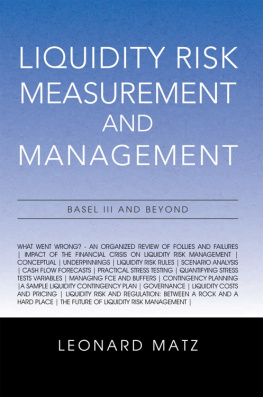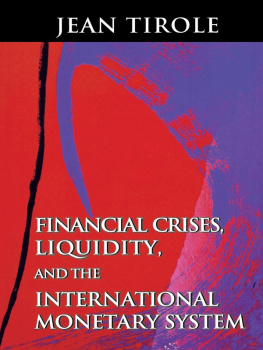Michael J. Howell - Capital Wars: The Rise of Global Liquidity
Here you can read online Michael J. Howell - Capital Wars: The Rise of Global Liquidity full text of the book (entire story) in english for free. Download pdf and epub, get meaning, cover and reviews about this ebook. publisher: Springer International Publishing, genre: Science. Description of the work, (preface) as well as reviews are available. Best literature library LitArk.com created for fans of good reading and offers a wide selection of genres:
Romance novel
Science fiction
Adventure
Detective
Science
History
Home and family
Prose
Art
Politics
Computer
Non-fiction
Religion
Business
Children
Humor
Choose a favorite category and find really read worthwhile books. Enjoy immersion in the world of imagination, feel the emotions of the characters or learn something new for yourself, make an fascinating discovery.
- Book:Capital Wars: The Rise of Global Liquidity
- Author:
- Publisher:Springer International Publishing
- Genre:
- Rating:3 / 5
- Favourites:Add to favourites
- Your mark:
- 60
- 1
- 2
- 3
- 4
- 5
Capital Wars: The Rise of Global Liquidity: summary, description and annotation
We offer to read an annotation, description, summary or preface (depends on what the author of the book "Capital Wars: The Rise of Global Liquidity" wrote himself). If you haven't found the necessary information about the book — write in the comments, we will try to find it.
Capital Wars: The Rise of Global Liquidity — read online for free the complete book (whole text) full work
Below is the text of the book, divided by pages. System saving the place of the last page read, allows you to conveniently read the book "Capital Wars: The Rise of Global Liquidity" online for free, without having to search again every time where you left off. Put a bookmark, and you can go to the page where you finished reading at any time.
Font size:
Interval:
Bookmark:


Cover illustration: vladimir3d, shutterstock.com
This Palgrave Macmillan imprint is published by the registered company Springer Nature Switzerland AG
The registered company address is: Gewerbestrasse 11, 6330 Cham, Switzerland
To the Salomon Brothers Diaspora
History, particularly financial history, is not random. The key idea in this book is that economic cycles are driven by financial flows, namely quantities of savings and credits, and not by high street inflation or the level of interest rates. Their sweeping destructive powers are expressed through Global Liquidity, a US$130 trillion pool of footloose cash. Our Central Bank policy-makers should, consequently, about-turn and focus more on financial stability than on hitting phantom consumer price inflation targets. The economist John Maynard Keynes distinguished the economys financial and industrial spheres in a similar way to how we might, today, separate the asset economy from the real economy. Trying to stimulate the real economy with liquidity always runs the risk of creating asset price bubbles instead. In the 1930s, facing a near-identical situation to the post-GFC years, policy-makers then unleashed an analogous stimulus with the same outturn: near-flat high street prices, but soaring asset prices. A fractured, uncertain World encourages investors to hold excessive amounts of safe assets, like cash and government bonds and, particularly, US dollar assets, rather than putting money to work productively. When the State fails to produce sufficient safe assets, then the private sector steps in with less good substitutes, whose values unfortunately move procyclically. Governments austerity policies and quantitative tightening programmes might not sound such good ideas in this light? Think of this mechanism as the so-calledprecautionary demand for money, hurriedly skipped over in the traditional textbooks, but which seems to better describe the growing systemic risks we face than the better-known speculative motive, which assesses the chances of rising (as opposed to falling) interest rates and can lead to a liquidity trap. I argue that Global Liquidity is never trapped: it waves no flag, knows no boundaries and shifts all too rapidly between markets and asset classes.
What appear as two puzzling features in the latest policy debates, in fact, emphasise the importance of Global Liquidity. First, the widespread consensus view, underpinned by repeated Central Bank claims, that more QE (quantitative easing) lowers, and does not raise, term premia and hence government bond yields. The academic argument, summarised by Gagnon (2016), quantifies this as 67 basis points (bp) per 10% of GDP injected via QE. Second, many believe that the slope of the yield curve is an unambiguous predictor of the business cycle. Hence, an inverted yield curve should warn us that a recession is fast approaching. In fact, neither statement is true. The former is easily refuted by the data, which show that QE periods in the US have unequivocally been associated with higher yields, with term premia rising by an average 134 bp through each past QE phase. The efficiency of the Treasury yield curve as a predictor of the business cycle is analysed elsewhere (Howell 2018). This confirms that the standard 10-2 year yield curve slope is, at best, a flaky predictor. This analysis points out that, because different maturity spreads work at different times, what also matters is the curvature of the term structure. In other works, slope and curvature must be assessed together. A key component explaining curvature is the pattern of term premia. Term premia are liquidity phenomena, largely reflecting the excess demand for safe assets.
The liquidity shocks that ricocheted across the World in 1989 as the Berlin Wall fell ultimately forced interest rates down and helped to reverse the polarity of the global financial system. Capital raced Eastwards along what I call theFinancial Silk Road, while politics and people marched West, causing too many countries, and notably China, to lean too heavily on the US dollar and the US Treasury market for safety. Linked to these changes, todays financial markets increasingly have to serve asrefinancing mechanismsrather than asnew financing mechanisms, making the capacity of capital, i.e. balance sheet size, more important than the cost of capital, i.e. the level of interest rates. The heightened supply of poor quality safe assets, or what I more formally describe as theshadow monetary base, compromises the ability of private balance sheets to roll over the huge volumes of outstanding debts left over from the GFC era. Ironically, a reduced supply of liquidity and safe assets, increases the demand to hoard them. Together these features amplify the swings in Global Liquidity and explain why, as the World has got bigger, it has also become more volatile. The underlying scarcity of high-quality assets leads on toCapital Wars.Here, the battleground embraces money, technology and geopolitics, with the struggle fought out between the two key superpowers: Chinese industry and American finance. Chinas presence is weighing more and more: in the year 2000, China accounted for 5.9% of Global Liquidity, or less than one-fifth of Americas share; Chinas share reached 10.1% at the time of the 20072008 GFC and, today, it has swelled to a whopping 27.5%, significantly out-pacing Americas slipping 22.5% slice. China matters hugely to both the World economy and World finance. I conclude that whereas America needs to reinvigorate her industry, China has the more pressing need to rapidly develop her financial sector. Like history, these are processes, not events, but we can still ask whether the final victor in the markets will be the US dollar or a digitally based Chinese Yuan?
Font size:
Interval:
Bookmark:
Similar books «Capital Wars: The Rise of Global Liquidity»
Look at similar books to Capital Wars: The Rise of Global Liquidity. We have selected literature similar in name and meaning in the hope of providing readers with more options to find new, interesting, not yet read works.
Discussion, reviews of the book Capital Wars: The Rise of Global Liquidity and just readers' own opinions. Leave your comments, write what you think about the work, its meaning or the main characters. Specify what exactly you liked and what you didn't like, and why you think so.













